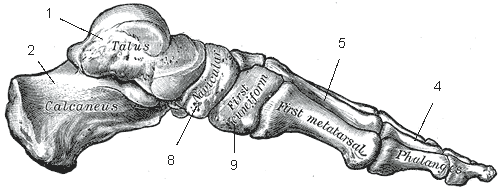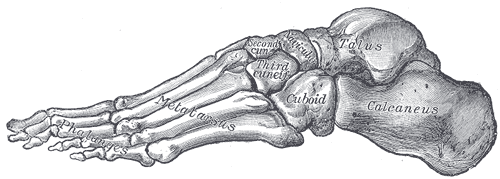Arches of the Foot: Difference between revisions
No edit summary |
Evan Thomas (talk | contribs) mNo edit summary |
||
| Line 50: | Line 50: | ||
== References == | == References == | ||
<references /> | <references /><br> | ||
[[Category:Anatomy]] | [[Category:Anatomy]] [[Category:Foot]] [[Category:Biomechanics]] [[Category:Musculoskeletal/Orthopaedics]] | ||
Revision as of 06:24, 9 January 2017
Original Editor - Evan Thomas
Top Contributors - Kim Jackson, Daniele Barilla, Evan Thomas, Adam Vallely Farrell, Uchechukwu Chukwuemeka, Lucinda hampton, Mariam Hashem, WikiSysop and Vidya Acharya
Introduction[edit | edit source]
There are three arches of the foot:
- Medial Longitudinal
- Lateral Longitudinal
- Transverse
Anatomy[edit | edit source]
Medial Arch[edit | edit source]
The medial arch is made up by the calcaneus, the talus, the navicular, the three cuneiforms, and the first, second, and third metatarsals. Its summit is at the superior articular surface of the talus, and its two extremities or piers, on which it rests in standing, are the tuberosity on the plantar surface of the calcaneus posteriorly and the heads of the first, second, and third metatarsal bones anteriorly. The chief characteristic of this arch is its elasticity, due to its height and to the number of small joints between its component parts. Its weakest part, i. e., the part most liable to yield from overpressure, is the joint between the talus and navicular, but this portion is braced by the plantar calcaneonavicular ligament, which is elastic and is thus able to quickly restore the arch to its pristine condition when the disturbing force is removed. The ligament is strengthened medially by blending with the deltoid ligament of the ankle-joint, and is supported inferiorly by the tendon of the Tibialis posterior, which is spread out in a fanshaped insertion and prevents undue tension of the ligament or such an amount of stretching as would permanently elongate it. The arch is further supported by the plantar aponeurosis, by the small muscles in the sole of the foot, by the tendons of the Tibialis anterior and posterior and Peronæus longus, and by the ligaments of all the articulations involved. [1]
Lateral Arch[edit | edit source]
The lateral arch is composed of the calcaneus, the cuboid, and the fourth and fifth metatarsals. Its summit is at the talocalcaneal articulation, and its chief joint is the calcaneocuboid, which possesses a special mechanism for locking, and allows only a limited movement. The most marked features of this arch are its solidity and its slight elevation; two strong ligaments, the long plantar and the plantar calcaneocuboid, together with the Extensor tendons and the short muscles of the little toe, preserve its integrity.[1]
While these medial and lateral arches may be readily demonstrated as the component antero-posterior arches of the foot, yet the fundamental longitudinal arch is contributed to by both, and consists of the calcaneus, cuboid, third cuneiform, and third metatarsal: all the other bones of the foot may be removed without destroying this arch.[1]
Transverse arch[edit | edit source]
In addition to the longitudinal arches the foot presents a series of transverse arches. At the posterior part of the metatarsus and the anterior part of the tarsus the arches are complete, but in the middle of the tarsus they present more the characters of half-domes the concavities of which are directed downward and medialward, so that when the medial borders of the feet are placed in apposition a complete tarsal dome is formed. The transverse arches are strengthened by the interosseous, plantar, and dorsal ligaments, by the short muscles of the first and fifth toes (especially the transverse head of the Adductor hallucis), and by the Peronæus longus, whose tendon stretches across between the piers of the arches.[1]
Video[edit | edit source]
Clinical Relevance[edit | edit source]
Pes planus or pes valgus (flat foot)
Pes cavus (claw foot)
Hallux Valgus
Hammer Toe
Club foot (talipes equinovarus)
Recent Related Research (from Pubmed)[edit | edit source]
Failed to load RSS feed from https://eutils.ncbi.nlm.nih.gov/entrez/eutils/erss.cgi?rss_guid=1NukREZ-I2Nu5VY4MAGWSrjYSP6ZUCM9XR_YGSqkMlIC9GMsHL|charset=UTF-8|short|max=10: There was a problem during the HTTP request: 500 Internal Server Error









